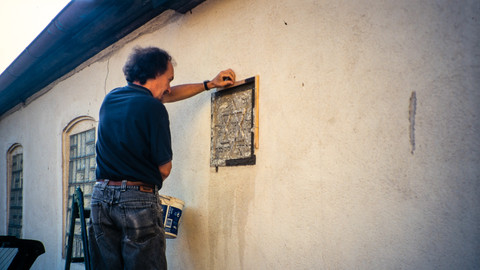Chuppah Stone
The Jewish wedding ceremony originally took place outside the synagogue under a canopy (= Hebrew chuppah). A stone set into the synagogue wall marks the place where the marriage was performed. As a symbol, stars are usually found in various forms. The star is a reification of the Hebrew word masal ( = sign, good sign > good luck), therefore next to the star in most wedding stones in Hebrew script the signs for masl tov (= good luck) are engraved. After the wedding ceremony, the groom breaks a glass on the ground or on the synagogue wall or on the wedding stone itself. The breaking of the glass is supposed to remind of the destruction of the temple, according to another account of the transience of life.
Wedding stones are practically found only in southern Germany and in this form of a so-called Star of David, the one in Obernbreit is the second oldest. The oldest one can be found at the synagogue in Ansbach.
The present condition is the result of a restoration arranged and financed by the former local pastor, Helmut Walz,(d. 2011) for his 60th birthday. Previously, the stone was in poor condition, partially obscured and weathered by plaster and paint. Nevertheless, it was the only sign that the building was the former synagogue. However, it was hardly noticed by the inhabitants or reinterpreted as a brewery star.
In the center of the star, the wish "masel tov" (= good luck) is written in Hebrew script; compare the expression "Massel haben" (to be lucky), which comes from Yiddish.
On the upper right and left is a quotation from the prophet Jeremiah, which continues on the lower right and left. (Jer- 7.34 and 33.11 respectively). It means: voice of rejoicing - voice of joy - voice of the bridegroom - voice of the bride. The quotation is part of one of the seven blessings said by those present at the conclusion of the wedding ceremony for the bride and groom.
The characters to the right and left of the star stand for the year 5508, which according to our calendar is 1748, the year the synagogue was built. This date was also confirmed by dendrochronological examinations of the timber.







